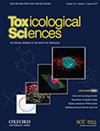Cadmium inhibits calcium activity in hippocampal CA1 neurons of freely moving mice
IF 3.4
3区 医学
Q2 TOXICOLOGY
引用次数: 0
Abstract
Cadmium (Cd) is a ubiquitous toxic heavy metal and a potential neurotoxicant due to its wide use in industrial manufacturing processes and commercial products, including fertilizers. The general population is exposed to Cd through food and smoking due to high transfer rates of Cd from contaminated soil. Cd has been shown to mimic calcium ions (Ca2+) and interfere with intracellular Ca2+ levels and Ca2+ signaling in in vitro studies. However, nothing is known about Cd’s effects on Ca2+ activity in neurons in live animals. This study aimed to determine if Cd disrupts Ca2+ transients of neurons in CA1 region of the hippocampus during an associative learning paradigm. We utilized in vivo Ca2+ imaging in awake, freely moving C57BL/6 mice to measure Ca2+ activity in CA1 excitatory neurons expressing genetically encoded Ca2+ sensor GCaMP6 during an associative learning paradigm. We found that a smaller proportion of neurons are activated in Cd-treated groups compared to control during fear conditioning, suggesting that Cd may contribute to learning and memory deficit by reducing activity of neurons. We observed these effects at Cd exposure levels that result in blood Cd levels comparable to the general US population levels. This provides a possible molecular mechanism for Cd interference of learning and memory at exposure levels relevant to US adults. To our knowledge, our study is the first to describe Cd effects on brain Ca2+ activity in vivo in freely behaving mice.镉抑制自由活动小鼠海马 CA1 神经元的钙活动
镉(Cd)是一种无处不在的有毒重金属,也是一种潜在的神经毒物,因为它被广泛应用于工业生产过程和商业产品(包括化肥)中。由于镉从受污染土壤中的转移率很高,普通人群会通过食物和吸烟接触到镉。体外研究表明,镉能模拟钙离子(Ca2+),干扰细胞内 Ca2+ 水平和 Ca2+ 信号传导。然而,人们对镉对活体动物神经元中 Ca2+ 活性的影响一无所知。本研究旨在确定镉是否会在联想学习范式中干扰海马CA1区神经元的Ca2+瞬态。我们利用体内 Ca2+ 成像技术对清醒、自由活动的 C57BL/6 小鼠进行了联想学习范式实验,测量了表达基因编码的 Ca2+ 传感器 GCaMP6 的 CA1 兴奋性神经元的 Ca2+ 活动。我们发现,与对照组相比,镉处理组在恐惧条件反射过程中激活的神经元比例较小,这表明镉可能通过降低神经元的活性导致学习和记忆缺陷。我们在镉暴露水平下观察到了这些效应,其血液中的镉水平与美国普通人群的水平相当。这为镉在与美国成年人相关的暴露水平下干扰学习和记忆提供了一种可能的分子机制。据我们所知,我们的研究首次描述了镉对自由行为小鼠体内大脑 Ca2+ 活动的影响。
本文章由计算机程序翻译,如有差异,请以英文原文为准。
求助全文
约1分钟内获得全文
求助全文
来源期刊

Toxicological Sciences
医学-毒理学
CiteScore
7.70
自引率
7.90%
发文量
118
审稿时长
1.5 months
期刊介绍:
The mission of Toxicological Sciences, the official journal of the Society of Toxicology, is to publish a broad spectrum of impactful research in the field of toxicology.
The primary focus of Toxicological Sciences is on original research articles. The journal also provides expert insight via contemporary and systematic reviews, as well as forum articles and editorial content that addresses important topics in the field.
The scope of Toxicological Sciences is focused on a broad spectrum of impactful toxicological research that will advance the multidisciplinary field of toxicology ranging from basic research to model development and application, and decision making. Submissions will include diverse technologies and approaches including, but not limited to: bioinformatics and computational biology, biochemistry, exposure science, histopathology, mass spectrometry, molecular biology, population-based sciences, tissue and cell-based systems, and whole-animal studies. Integrative approaches that combine realistic exposure scenarios with impactful analyses that move the field forward are encouraged.
文献相关原料
| 公司名称 | 产品信息 | 采购帮参考价格 |
|---|
 求助内容:
求助内容: 应助结果提醒方式:
应助结果提醒方式:


